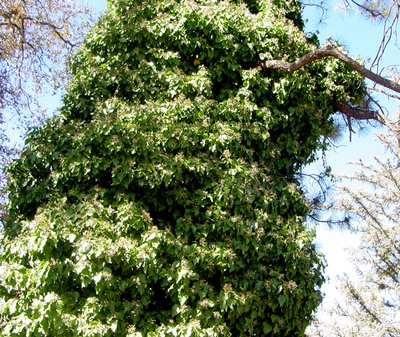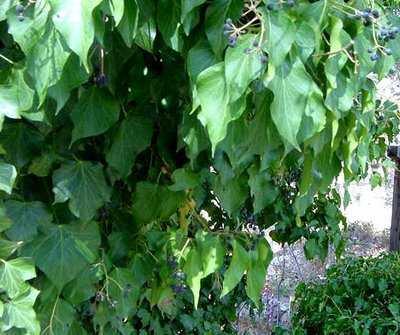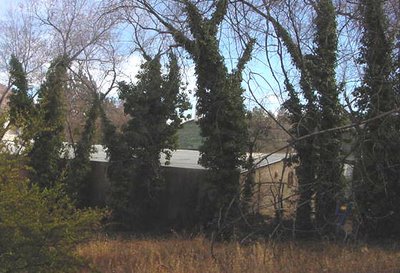 Ever take a look at those big old trees thick with ivy? I mean four--six--maybe eight feet across. Prescott's older neighborhoods are full of such trees, if you keep your eyes open. Here's an especially good example I found along Park Ave. There's another thoroughly buried tree north on Granite St. near the downtown Chase bank parking lot. Somewhere in the middle of that jungle of ivy is a tree.
Ever take a look at those big old trees thick with ivy? I mean four--six--maybe eight feet across. Prescott's older neighborhoods are full of such trees, if you keep your eyes open. Here's an especially good example I found along Park Ave. There's another thoroughly buried tree north on Granite St. near the downtown Chase bank parking lot. Somewhere in the middle of that jungle of ivy is a tree.Once you spot such a ivy, take a closer look. In the right season, you'll see little flowers, and most of the year, there will be little dark blue berries in clusters. Certainly not the English ivy of my mind's eye or, I presume, yours.
Proper ivy is a vine that clings sveltly to a tree or building--or covers the ground. It's leaves, that's all. No flowers. No seeds. Just nice, well behaved deep green, notched leaves. Everybody knows that. That's why it's so popular as a landscape plant.
So what's with these overgrown, blowsy ivied trees I'm pointing at? Well, such vines have been around a long time. They're old -- and they've reached the limits of their climb. There's only one thing to do: grow out. If you push some leaves aside, you'll see that the ivy has sprouted tough branches. And a closer look shows that the leaves are shaped differently -- they aren't notched!

What the ivy has done is Grown Up. At last. These are Adult Ivies. And I'm using the term "adult" in its more sinful sense. In our modern world "adult" either means over the hill (as in "active adult community") or sinful, not for the kiddies (as in "adult" bookstore or "adults only"). Yes -- these are ivies engaging in plant sex ... flowers, seeds, and all that entails.
I suppose that's why the nurseries I found by Googling the term "adult ivy" apparently preferred the more sedate form, "mature ivy". Here's what Country Living had to say:
Part of the ancients' reverence for ivy may have had to do with its bizarre habit of undergoing a fascinating biological change when it gets the chance to fully mature -- hence the allusion earlier to "ivy wood." Gardeners in milder climes are more than familiar with the fully mature ivy's habit (some may say pernicious penchant) of ascending 20, 30, often 40 feet into the tops of trees, where a strange thing happens: When the vines can climb no farther, they undergo a change, becoming a quasi tree.
 In this adult, or arborescent, form, the leaves, which previously were five-lobed and pointed, become elliptical and lose their lobes; the vines themselves thicken into upright stems, and the plant flowers (with greenish-yellow blooms) and produces berries that are the delight of birds (and, of course, help spread new ivy plants). When cuttings are taken from these metamorphosed versions and planted, the plants that grow from the cuttings don't revert to vines; rather, they will form bushes or small trees, whence "ivy wood."
In this adult, or arborescent, form, the leaves, which previously were five-lobed and pointed, become elliptical and lose their lobes; the vines themselves thicken into upright stems, and the plant flowers (with greenish-yellow blooms) and produces berries that are the delight of birds (and, of course, help spread new ivy plants). When cuttings are taken from these metamorphosed versions and planted, the plants that grow from the cuttings don't revert to vines; rather, they will form bushes or small trees, whence "ivy wood."Turns out that planting hedges of bush ivy is fashionable in some parts of California. And, bless Google, I also found out that in more benign climates, with enough moisture for ivy to go wild, it often turns into a real pest, like vinca down along parts of Oak Creek. It's illegal to sell ivy in Oregon! More info at this site which features a villanous, 8-ft. long ivy branch at least 4" in diameter on the home page.
No comments:
Post a Comment